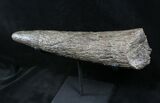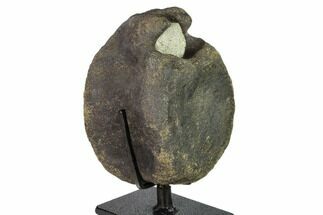This Specimen has been sold.
11" Juvenile Triceratops Horn With Stand - Montana
This is an 11" long horn of a juvenile Triceratops collected from the Hell Creek Formation of Montana. The last 2 inches of the tip were professionally restored and it's been mounted on a custom display stand. Unlike many fossils from the Hell Creek Formation, the horn has not been flattened or distorted by geological processes. The level of preservation is excellent as this was a "below ground" find, not collected from the surface where it may have been weathered.
About Triceratops
Triceratops is one of the most recognized and intriguing of the North American ceratopsid dinosaurs. They stomped around the Late Cretaceous (around 68-66 mya), brandishing their three-pronged and bony frilled skulls, chewing on fibrous plants. They struggled against large predators, stood their ground, and tried not to be devoured by the ferocious Tyrannosaurus rex.
The head on a Triceratops may have been an intimidating show rather than a stabbing, defensive trident and imposing shield for inter-species jousting. Researchers have given close scrutiny to the holes, or fenestrae, of other ceratopsid crests. In the past, the holes within the shield were used to confirm separate species.
Individual Triceratops are estimated to have reached up to 9 meters (29.5 feet) in length, 3 meters (9.8 feet) in height, and weighed up to 26,000 pounds. The largest known skull is estimated to have been 2.5 meters (8.2 feet) long and would have extended almost a third of the length of the mature individual. The pointed horns were approximately 1 meter (3 feet) long. With its sturdy build and powerful legs, Triceratops could have ripped open the predator that wanted this herbivore for dinner.
One of the most abundant of the large Cretaceous fauna, Triceratops plucked low growth with its beak-tipped jaws. Triceratops teeth were arranged in groups, called batteries, of 36 to 40 tooth columns, in each side of each jaw. Each column contained about 3 to 5 stacked teeth, depending on the individual’s size. This produced a range of 432 to 800 teeth, of which only a fraction were in use at any given time (due to tooth replacement). The great size and quantity of teeth suggests that they ate large volumes of fibrous plants. These were possibly palms, cycads, and ferns.
Triceratops was designated as the state fossil of South Dakota in 1988.
Triceratops is one of the most recognized and intriguing of the North American ceratopsid dinosaurs. They stomped around the Late Cretaceous (around 68-66 mya), brandishing their three-pronged and bony frilled skulls, chewing on fibrous plants. They struggled against large predators, stood their ground, and tried not to be devoured by the ferocious Tyrannosaurus rex.
The head on a Triceratops may have been an intimidating show rather than a stabbing, defensive trident and imposing shield for inter-species jousting. Researchers have given close scrutiny to the holes, or fenestrae, of other ceratopsid crests. In the past, the holes within the shield were used to confirm separate species.
Individual Triceratops are estimated to have reached up to 9 meters (29.5 feet) in length, 3 meters (9.8 feet) in height, and weighed up to 26,000 pounds. The largest known skull is estimated to have been 2.5 meters (8.2 feet) long and would have extended almost a third of the length of the mature individual. The pointed horns were approximately 1 meter (3 feet) long. With its sturdy build and powerful legs, Triceratops could have ripped open the predator that wanted this herbivore for dinner.
One of the most abundant of the large Cretaceous fauna, Triceratops plucked low growth with its beak-tipped jaws. Triceratops teeth were arranged in groups, called batteries, of 36 to 40 tooth columns, in each side of each jaw. Each column contained about 3 to 5 stacked teeth, depending on the individual’s size. This produced a range of 432 to 800 teeth, of which only a fraction were in use at any given time (due to tooth replacement). The great size and quantity of teeth suggests that they ate large volumes of fibrous plants. These were possibly palms, cycads, and ferns.
Triceratops was designated as the state fossil of South Dakota in 1988.
SPECIES
Triceratops horridus
LOCATION
Carter County, Montana
FORMATION
Hell Creek Formation
SIZE
11" wide
CATEGORY
SUB CATEGORY
ITEM
#26870
We guarantee the authenticity of all of our specimens.
 Reviews
Reviews
















